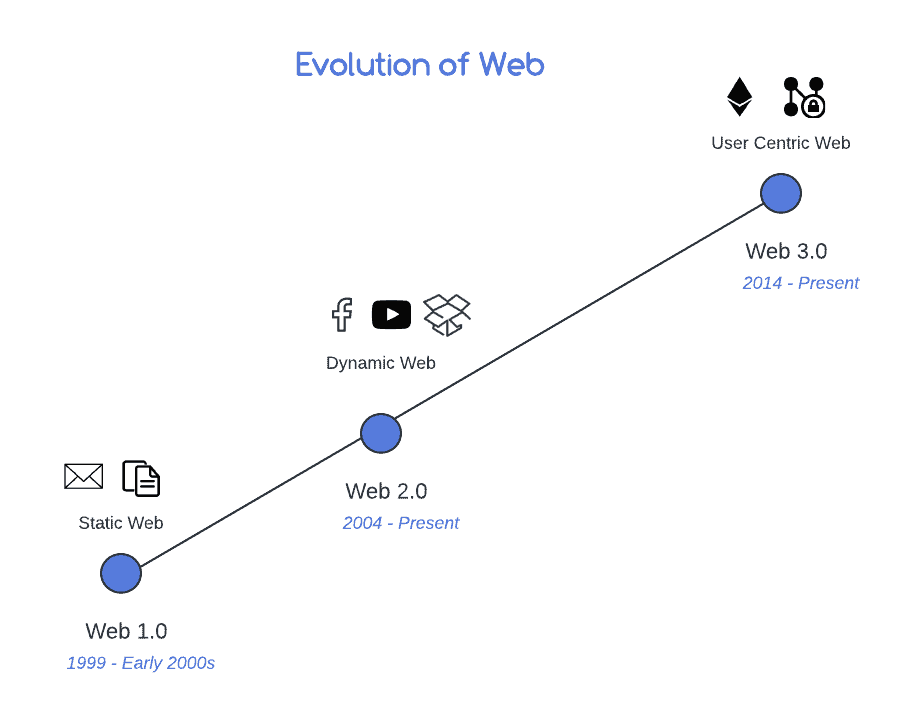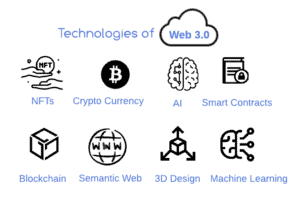Learn through the super-clean Baeldung Pro experience:
>> Membership and Baeldung Pro.
No ads, dark-mode and 6 months free of IntelliJ Idea Ultimate to start with.
Last updated: April 23, 2024
Nowadays, many people wonder if the way they interact with the internet will change due to the popularity of Web 3.0. However, some of us still confuse this new term, Web 3.0, and try to figure out if it’s the future of the internet or a scam.
In this tutorial, we’ll understand the concept of Web 3.0. Then, we’ll also discuss its features and its core technologies. Finally, we’ll unveil its benefits and limitations.
Notably, we’ll delve into topics like blockchain, Artificial Intelligence (AI), Machine Learning, and Natural Language Processing (NLP) to understand the concept of Web 3.0.
Before diving into Web 3.0, let’s discuss the evolution of the Web:

We’ll briefly understand the contexts of Web 1.0, Web 2.0, and the emergence of Web 3.0.
Back in 1991, the first website came into existence. At that time, websites contained some simple, read-only web pages. These websites were hard to access, as users required their complete URLs to access them due to the absence of search engines.
Due to the read-only nature of websites, people refer to Web 1.0 as the static web.
Continuing onward, the first Web 2.0 conference was held in 2004 to introduce several new applications. Moreover, YouTube was launched in 2005, playing a vital role in the evolution of the web and making content generation easier for users.
Web 2.0 is also known as the dynamic web because it enables users to read and write on websites.
We can write website content in various forms, such as blogs, forums, wikis, account logins, etc. Furthermore, social media platforms and cloud technology are the backbone of Web 2.0. These technologies allow us to interact with each other, store our data, and collaborate with peers.
Today a question arises: if we can already read and write data on the web, why do we require the next generation of the web, Web 3.0? Let’s understand the reason behind it.
Firstly, in Web 2.0, our data is monitored and managed by centralized authorities, which results in giant companies like Google, YouTube, Apple, and Meta (formerly known as Facebook) having control over our data. These companies use our data for the advancement of their platforms and also sell it to advertisers without our permission, resulting in us receiving ads tailored to our likings and requirements. Consequently, we become products for these companies to get monetary benefits from our data and breach our privacy without our consent.
Secondly, these intermediary bodies regulate and control our data. For instance, we can only upload a YouTube video that adheres to YouTube policies. However, if it violates any policy, YouTube will automatically remove it.
Thirdly, in terms of the economy, all our transactions are controlled and managed by intermediary bodies like banks, which lack transparency. This reliance on intermediary bodies not only causes delays in payment clearance but also reduces extra fees for their services. Apart from fees, we must provide our personal and financial details, resulting in a lack of privacy and security.
These were some of the main reasons why Web 3.0 came into existence.
Web 3.0 doesn’t have any standard definition, it’s a web that allows its users to read, write, and own their data. Users are responsible for sharing and selling their data to advertisers, giving them a sense of ownership and a monetary benefit.
Web 3.0 is a collection of ideas and practices for using technologies like ML, AI, blockchain, NLP, semantic architecture, and token-based economy to establish decentralization. This decentralization of data allows everybody involved in the distributed ledger (peer-to-peer) network to become responsible for storing and sharing data instead of depending on one big centralized tech company.
In simple terms, it enables users to control and own their data and content, allowing them to sell or trade it for a token-based economy. Web 3.0 stores and shares data in the form of nodes on a decentralized network, which means instead of a single entity controlling data on a central server, it’s distributed across many nodes (computers). This data distribution makes it impossible for hackers to tamper with data across all nodes.
Some people refer to Web 3.0 as Web3. This term was introduced in 2014 by Etherum’s owner. This concept of Web 3.0 has captivated numerous cryptocurrency enthusiasts, tech companies, and capital venture firms.
While Web 3.0 has yet to completely replace Web 2.0, it is no longer just a concept. It’s a tangible reality enabled by numerous technologies and services.
Nowadays, many groups of developers and cryptocurrency owners are developing their decentralized applications (dApps) on blockchain networks along with their own crypto tokens or crypto coins to gain monetary benefits. Some popular Web 3.0 applications we might have heard of are Brave, Sapien, and Stroj.
We’re still unsure how many new technologies, services, and concepts will emerge as Web 3.0 evolves. However, let’s explore some technologies that are reshaping the web, offering new possibilities for decentralization, transparency, and innovation:

Decentralized Applications (dApps) are applications built on blockchain to decentralize data and digital assets. It empowers users with greater control over their data and facilitates trustless transactions.
A wide range of dApps is available, ranging from gaming platforms to marketplaces, social networks, financial applications, exchanges, and more.
Decentralized Finance (DeFi) refers to financial services built on blockchain that disrupt the traditional finance system. DeFi allows users to borrow, lend, trade, and invest in a peer-to-peer manner using smart contracts and decentralized network protocols, offering them a new level of financial inclusion, transparency, and efficiency.
In simple terms, DeFi empowers users to access financial services without relying on intermediaries such as banks.
DAOs mean operating an organization without a hierarchy or central authorities such as CEOs or board members. Organizations use blockchain to record their purpose, goals, rules, and plans. Furthermore, they employ smart contracts to execute rules and make decisions based on votes from the members.
NFTs are unique identifiers recorded on the blockchain to represent ownership of digital content, such as artwork, collectibles, virtual real estate, and more. Owners can sell or trade their NFTs in exchange for cryptocurrency. Therefore, they provide a new way for artists to protect and monetize their digital assets.
Let’s now discuss some of the features offered by Web 3.0.
5.1. Advanced Technologies
Web 3.0 leverages advanced technologies like AI, ML, blockchain, and the Internet of Things (IoT) to redefine the web and establish decentralization of data. These technologies offer users a more dynamic, secure, efficient, and rewarding web.
Web 3.0 data is more connected and available, enabling users to access internet services and content anytime, anywhere, from numerous devices like mobiles, laptops, sensors, smart appliances, and more. Consequently, this feature has opened gates for more advanced applications and technologies, enabling users to stay more connected.
Web 3.0 has taken graphics to another level, as its websites and services use virtual reality, augmented reality, 3D designs, and 3D models in all fields, including gaming and real estate.
To better understand this, we can consider the metaverse, which provides an immense experience by combining 3D design, virtual reality, and the real world.
Another feature of Web 3.0 is its trustlessness and permissionlessness. let’s understand what this means. As we know, Web 3.0 applications are open-source, so anyone with internet access can use them. Users don’t require permission from central authorities to participate or an intermediary to access them.
As discussed earlier, Web 3.0 allows users to own their data and sell or trade it for cryptocurrency. Futuristics says Web 3.0 is gradually redefining the traditional economy and will replace it with decentralized cryptocurrency.
Although we can’t say for certain whether it will become a reality, we can still invest some amount in a promising cryptocurrency by seeking expert financial advice to benefit from this emerging technology.
This way, we’ve discussed some of the Web 3.0 features.
Finally, let’s conclude our discussion by highlighting some of the benefits and limitations of Web 3.0:
| Benefits | Limitations |
|---|---|
| It uses NLP and semantic metadata to understand data in a human-like manner, resulting in better search results. | Many users still hesitate to use Web 3.0 due to a lack of awareness and knowledge. |
| Web 3.0 offers transparency of finances as it records every transaction on the blockchain. | Accessing Web 3.0 can pose affordability issues for some users, as it requires advanced devices with better specifications. |
| It mitigates the risk of data breaches and hacking because of its data distribution across a network of nodes. | In Web 3.0, halting misinformation and hateful speech is challenging or almost impossible. |
| Web 3.0 leverages AI to offer users a more personalized browsing experience. | As a beginner, understanding and working with Web 3.0 can be complicated. |
In this article, we had a brief look into the Web 3.0 world. We understood how it leverages advanced technologies, including blockchain, AI, ML, NLP, semantic architecture, and 3D designs, to establish decentralization.
In brief, this new phase of the web is evolving gradually, and futurists believe it’ll replace Web 2.0 and the traditional economic system.